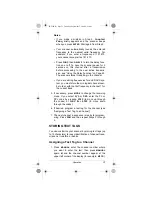
28
About Your Scanner
widely available on the Internet for most Type I systems
in use.
Type II system talk groups are identified by a 5-digit
number. Valid talk group IDs are divisible by 16. If you
try to enter an invalid talk group ID, the scanner rounds
the ID down to the next valid ID.
Type I/II hybrid systems use both fleet-subfleet and 5-
digit formats for talk group IDs.
Note: If the scanner decodes control channel data while
receiving transmissions from a Motorola trunking sys-
tem,
CNTRL
appears on the bottom line of the display.
EDACS Mode
You can set your scanner so it decodes the talk group
IDs used with EDACS (GE/Ericsson) trunking systems.
This setting is called the EDACS mode.
EDACS systems are trunking systems used primarily by
business or private communications service providers,
as well as by some public safety organizations. EDACS
systems transmit active talk group information only on a
dedicated control channel.
EDACS frequencies are organized in a specific order.
Each frequency is assigned a Logical Channel Number
(LCN). For the scanner to correctly switch to an active
frequency, you must program the frequencies in LCN or-
der, starting with Memory 01. EDACS talk group IDs are
entered as a 4-digit decimal number from 0000 to 4095.
When there is activity on an EDACS system, that infor-
mation is sent out on the control channel. The scanner
decodes the ID for the active talk group. In the open
mode, the scanner then goes to the transmission and
displays the talk group ID on the bottom line of the dis-
play. In the closed mode, the scanner only goes to trans-
missions with IDs that match talk group IDs you have
stored in the bank’s talk group ID list which are not
locked out.
Because EDACS scanning requires clear reception of
the control channel at all times, EDACS systems tend to
have a smaller usable area. An external antenna can
20-522b.fm Page 28 Thursday, September 7, 2000 9:41 AM















































